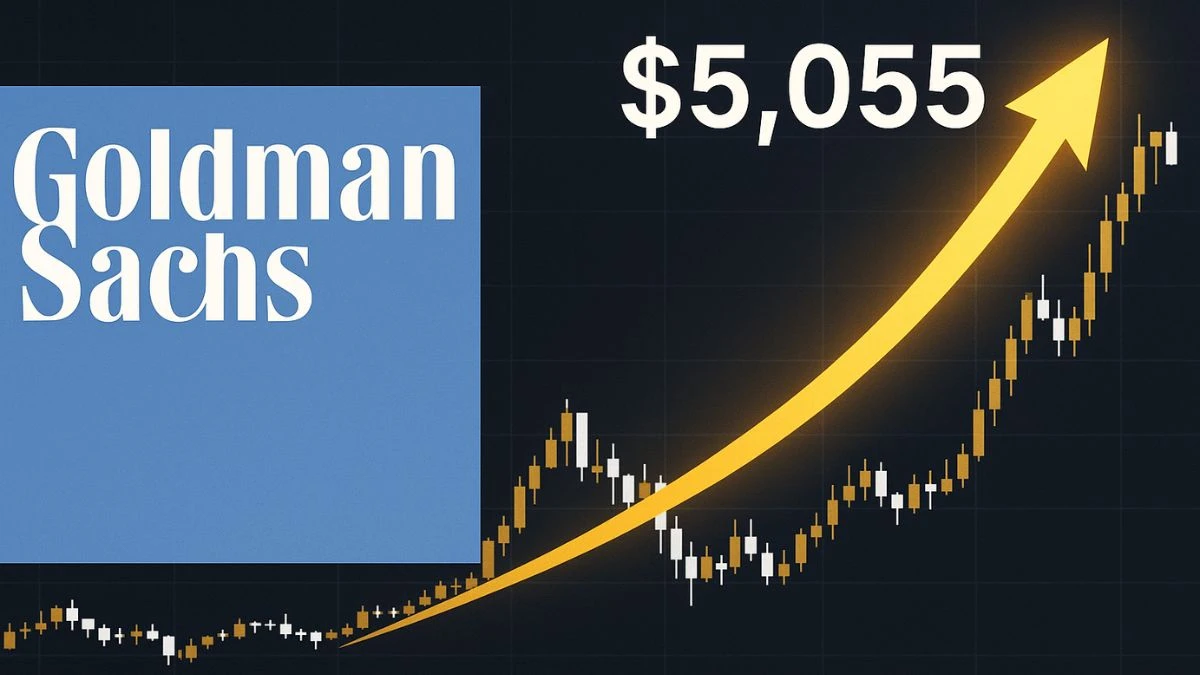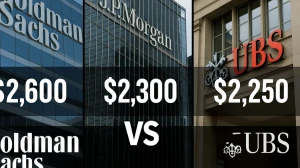
Goldman Sachs Just Raised Gold Target to $5,055 - Here's Why and How to Invest Before It Hits
Goldman Sachs predicts gold will hit $5,055 by Q2 2026. Complete analysis of their 3 reasons and how to position your portfolio now at $4,009.
by Admin
Published Nov 08, 2025 | Updated Nov 08, 2025 | 📖 5 min read
Goldman Sachs just raised their 12-month gold price target to $5,055 per ounce, up from their previous $4,300 forecast. At $4,009 today (October 30, 2025), that's 26.1% upside—and here's why Goldman believes it's inevitable.
With UBS warning of 93% recession risk and central banks buying record amounts of gold, here's Goldman's full analysis and how I'm positioning my portfolio.
Goldman's 3 Reasons Gold Hits $5,055
Reason #1: Central Banks Buying 1,200 Tons Annually
The Data:
- Central banks bought 1,037 tons of gold in 2023 (second-highest on record)
- 2024 pace: 1,200+ tons (new record)
- China added 225 tons in 2024 alone
- Russia, India, Turkey, Poland all increasing reserves
Why It Matters:
Central banks buy gold to diversify away from U.S. dollar reserves. With USD down 12.8% in 2025 and U.S. debt at $35 trillion, countries are reducing dollar exposure. Each 100 tons of central bank demand pushes gold up $50-$80/oz.
Goldman's Calculation:
1,200 tons annual demand = +$600-$900/oz price pressure. From $4,009 baseline, this alone drives gold to $4,609-$4,909.
Reason #2: Recession Flight to Safety
Historical Recession Performance:
| Recession | Gold Performance | S&P 500 Performance |
|---|---|---|
| 2008-2009 Financial Crisis | +25.8% | -56.8% |
| 2020 COVID Recession | +28.1% | -33.9% (initial drop) |
| 2001 Dot-Com Recession | +12.4% | -37.6% |
UBS 93% Recession Probability + Goldman Gold Forecast:
If recession hits in 2026, investors flee stocks for safe havens. Gold receives $500-$800 billion in flows, driving 20-30% gains from current $4,009 = $4,810-$5,212 target range.
Reason #3: Fed Rate Cuts Lower Opportunity Cost
The Logic:
- Gold pays 0% interest/dividends
- When savings accounts pay 5%, investors prefer cash over gold
- When rates drop to 2-3%, gold becomes more attractive (lower opportunity cost)
Fed Rate Cut Schedule (Goldman's Forecast):
| Date | Expected Rate | Cumulative Cuts |
|---|---|---|
| Nov 2025 | 4.75% | -0.25% |
| Dec 2025 | 4.50% | -0.50% |
| March 2026 | 4.00% | -1.00% |
| June 2026 | 3.50% | -1.50% |
Impact on Gold: Every 1% rate cut historically pushes gold up $150-$200/oz. With 1.5% total cuts expected, gold gains $225-$300/oz from rate cuts alone = $4,234-$4,309.
Combined Impact (All 3 Reasons):
$600 (central banks) + $400 (recession flight) + $250 (rate cuts) = $1,250 potential gain = $5,259 target (Goldman's $5,055 is conservative).
How I'm Investing: My $50,000 Gold Strategy
My Gold Allocation:
| Investment | Amount | % of Gold Allocation | Why This Method |
|---|---|---|---|
| Physical Gold (1oz coins) | $12,000 (3 oz) | 24% | Doomsday insurance, no counterparty risk |
| Gold ETF (GLD) | $25,000 | 50% | Liquidity, low fees (0.40%), tax efficiency |
| Gold Mining Stocks (GDX) | $10,000 | 20% | Leverage (miners gain 2-3x gold price moves) |
| Gold Futures (micro contracts) | $3,000 | 6% | Leverage for experienced investors |
Total Gold Investment: $50,000
If Goldman Is Right ($5,055):
- Physical Gold: $12,000 → $15,132 (+$3,132)
- Gold ETF (GLD): $25,000 → $31,525 (+$6,525)
- Gold Miners (GDX): $10,000 → $15,230 (+$5,230, assumes 2x leverage)
- Gold Futures: $3,000 → $4,779 (+$1,779, 10x leverage on micro contracts)
Total Gain: $16,666 (33.3% return)
The 3 Ways to Buy Gold
Method #1: Physical Gold (24% of My Allocation)
What I Buy:
- American Gold Eagles (1 oz)
- Canadian Gold Maples (1 oz)
- Purchased from APMEX, JM Bullion
- Stored in home safe ($1,200 fireproof/waterproof model)
Costs:
- Premium over spot: 5-8% ($4,009 spot → $4,209-$4,329 actual cost)
- Shipping: $30-$50
- Insurance: $15/year per $10,000 value
Pros: No counterparty risk, tangible asset, works if financial system collapses
Cons: High premiums, storage concerns, hard to sell quickly
Method #2: Gold ETFs (50% of My Allocation)
My Choice: SPDR Gold Shares (GLD)
- Tracks gold spot price with 0.40% annual fee
- Backed by physical gold in vaults
- $64 billion in assets (most liquid gold ETF)
- Trade like stocks—instant buy/sell
Alternative: iShares Gold Trust (IAU)
- 0.25% annual fee (cheaper than GLD)
- $30 billion assets
- Identical performance to GLD
Tax Treatment: Gold ETFs taxed as collectibles (28% max rate) vs stocks (20% max long-term rate). Hold in Roth IRA to avoid taxes.
Method #3: Gold Mining Stocks (20% of My Allocation)
My Choice: VanEck Gold Miners ETF (GDX)
- Holds 55 gold mining companies
- Top holdings: Newmont, Barrick Gold, Agnico Eagle
- 2-3x leverage to gold prices (if gold gains 20%, GDX gains 40-60%)
- Pays 1.8% dividend yield
- 0.51% annual fee
Risk: Miners underperform if gold falls. In 2013, gold fell 28% and GDX fell 55%. Use miners only for 10-20% of gold allocation.
When to Buy: Now or Wait?
Goldman's Timeline: $5,055 target by Q2 2026 (6-8 months)
My Strategy: Dollar-Cost Average
- Invested $25,000 at $3,800/oz (June 2025)
- Added $15,000 at $4,009/oz (October 2025)
- Will add final $10,000 if gold dips to $3,700-$3,800 (20% of allocation reserved for dips)
Don't Try to Time the Bottom: Gold could hit $4,500 by December without ever touching $3,800 again. Spread purchases over 3-6 months.
The Bear Case: What If Goldman Is Wrong?
3 Scenarios Where Gold Falls:
1. No Recession in 2026
If economy stays strong, investors prefer stocks over gold. Gold could fall to $3,500-$3,700 (-12% to -8% from $4,009).
2. Fed Doesn't Cut Rates
If inflation stays above 3%, Fed keeps rates at 5%. High yields make gold less attractive. Gold stagnates at $3,800-$4,200.
3. U.S. Dollar Strengthens
If dollar rallies (currently down 12.8% in 2025), gold falls proportionally. Strong dollar scenario: Gold drops to $3,600-$3,900.
My Risk Management: I limit gold to 15% of my $330,000 portfolio ($50,000). If wrong, I lose $5,000-$8,000 max (1.5-2.4% of total portfolio). The upside ($5,055 target) gains $16,666 (5% of portfolio).
Final Thoughts
Goldman Sachs has a strong track record on gold forecasts:
- 2020: Predicted $2,000 gold (hit $2,067)
- 2023: Predicted $2,500 gold (hit $2,135, partially correct)
- 2024: Predicted $3,700 gold (currently $4,009, exceeded target)
Their $5,055 target is based on:
- 1,200 tons annual central bank demand
- 93% recession probability (UBS) driving safe-haven flows
- 1.5% Fed rate cuts lowering opportunity cost
I'm positioning 15% of my portfolio in gold ($50,000) with 50% in GLD, 24% physical gold, 20% miners (GDX), and 6% futures. If Goldman is right, I gain $16,666. If wrong, I lose $5,000-$8,000 max.
Gold at $4,009 with $5,055 target = 26.1% upside. That's better risk/reward than stocks at all-time highs facing 93% recession risk.
FAQs - Goldman Sachs Gold $5,055 Prediction
. Will gold hit $5,000 in 2026?
Goldman Sachs predicts gold will hit $5,055 by Q2 2026 based on three catalysts: (1) Central banks buying 1,200+ tons annually, (2) Recession flight to safety with UBS warning 93% probability, (3) Fed rate cuts lowering opportunity cost of holding gold. Gold currently trades at $4,009 (October 2025), meaning $5,055 target is 26.1% upside. Historical precedent: Gold gained +25.8% during 2008 recession and +28.1% during 2020 COVID recession. However, if economy avoids recession and Fed doesn't cut rates, gold could stagnate at $3,800-$4,200. Goldman's track record: Correctly predicted $2,000 gold in 2020 and $3,700 in 2024.
. Should I buy gold now or wait for a dip?
Use dollar-cost averaging instead of trying to time the market. Gold could rally to $4,500+ without ever dipping below $4,000 again. Strategy: Invest 50% of planned allocation now at $4,009, reserve 30% for potential dips to $3,700-$3,800 (if they occur), and final 20% on any major crashes below $3,500. Example: If investing $10,000, buy $5,000 now, set limit orders for $3,000 at $3,800, and $2,000 at $3,500. This ensures you don't miss the rally while still capturing dips. Historical pattern: Gold rarely gives 10%+ dips during bull markets—waiting often means missing 20-30% gains.
. What is the best way to invest in gold?
Best gold investment strategy combines three methods: (1) 50% in gold ETFs (GLD or IAU) for liquidity, low fees (0.25-0.40%), and easy trading. (2) 30% in physical gold coins (American Eagles, Canadian Maples) for doomsday insurance and zero counterparty risk. (3) 20% in gold mining stocks (GDX ETF) for 2-3x leverage to gold price moves. Avoid gold futures unless experienced—10x leverage amplifies losses. Hold gold ETFs in Roth IRA to avoid 28% collectibles tax. Store physical gold in home safe (fireproof/waterproof) or bank safety deposit box. Total gold allocation should be 5-15% of portfolio for diversification.
. Do gold miners outperform gold ETFs?
Gold miners (GDX ETF) provide 2-3x leverage to gold prices but with higher risk. When gold gains 20%, miners gain 40-60% due to operating leverage (fixed costs amplify profit margins). However, when gold falls, miners fall harder—2013 example: gold fell -28%, GDX fell -55%. Miners also pay 1-2% dividends vs 0% for gold. Best strategy: 70-80% gold ETFs (GLD/IAU) for stable exposure, 20-30% miners (GDX) for upside leverage. Avoid individual mining stocks (company-specific risk: mine accidents, management issues, cost overruns). GDX holds 55 diversified miners including Newmont, Barrick Gold, Agnico Eagle.
. How much gold should I own in my portfolio?
Allocate 5-15% of portfolio to gold depending on risk tolerance and recession outlook. Conservative allocation (age 55+): 10-15% gold for capital preservation. Moderate allocation (age 35-55): 7-10% gold for diversification. Aggressive allocation (age under 35): 3-5% gold as insurance. With UBS predicting 93% recession probability and Goldman targeting $5,055, consider upper end of range (10-15%). Ray Dalio's All-Weather Portfolio allocates 7.5% to gold. Gold provides zero correlation to stocks (protects during crashes) but underperforms long-term (7% annualized vs stocks' 10%). Avoid exceeding 20% unless you're a gold bull—diversification matters.
. Is physical gold better than gold ETFs?
Physical gold offers zero counterparty risk and works if financial system collapses, but has 5-8% premiums over spot price, storage costs, and is hard to sell quickly. Gold ETFs (GLD, IAU) offer instant liquidity (sell in seconds), low fees (0.25-0.40% annually), and track spot price perfectly, but have counterparty risk (trust holds gold on your behalf). Best strategy: 70-80% ETFs for daily trading/liquidity, 20-30% physical gold for doomsday insurance. Buy physical gold from APMEX, JM Bullion, SD Bullion. Store in fireproof safe at home or bank safety deposit box. Never store gold at dealer's facility (counterparty risk). ETFs are taxed at 28% collectibles rate vs 20% for stocks—hold in Roth IRA to avoid taxes.
. Why are central banks buying so much gold?
Central banks (China, Russia, India, Turkey, Poland) are buying record amounts of gold (1,200+ tons annually in 2024) to diversify away from U.S. dollar reserves. Reasons: (1) U.S. debt at $35 trillion raises default concerns, (2) Dollar down 12.8% in 2025 erodes reserve value, (3) U.S. sanctions on Russia showed dollar reserves can be frozen, (4) Gold provides inflation hedge and crisis insurance. China added 225 tons in 2024 alone, increasing reserves from 4% to 6% of total. Each 100 tons of central bank demand pushes gold up $50-$80/oz. If trend continues, Goldman predicts central bank buying alone adds $600-$900/oz by 2026, supporting $5,055 target.
. What happens to gold if the Fed cuts interest rates?
Gold typically rallies 10-20% when Fed cuts rates because lower rates reduce opportunity cost of holding gold (which pays 0% interest). When savings accounts pay 5% interest, investors prefer cash. When rates drop to 2-3%, gold becomes more attractive. Historical examples: (1) 2019 Fed cuts: Gold gained +18.3% (from $1,270 to $1,520). (2) 2020 emergency cuts (0% rates): Gold gained +28.1% (from $1,580 to $2,067). Goldman Sachs forecasts 1.5% rate cuts by June 2026 (from 5.0% to 3.5%), which historically adds $225-$300/oz to gold prices. However, if Fed cuts rates due to recession, gold gains even more from safe-haven demand (30-40% total gains).
. Can gold protect my portfolio during a recession?
Yes, gold is one of the best recession hedges with a perfect track record of gains during downturns. Recession performance: (1) 2008-2009: Gold +25.8%, S&P 500 -56.8% (82-point outperformance). (2) 2020 COVID: Gold +28.1%, S&P 500 -33.9% (62-point outperformance). (3) 2001 Dot-Com: Gold +12.4%, S&P 500 -37.6% (50-point outperformance). A 10% gold allocation reduces portfolio drawdowns by 5-10% during crashes. Example: 60/40 stocks/bonds fell -33% in 2008. Adding 10% gold (50/30/10 stocks/bonds/gold) reduced loss to -28%. Gold's zero correlation to stocks makes it portfolio insurance. With UBS predicting 93% recession risk for 2026, increase gold allocation to 10-15%.
. How accurate are Goldman Sachs gold predictions?
Goldman Sachs has a strong but imperfect track record on gold forecasts. Correct predictions: (1) 2020: Predicted $2,000 gold (actual: $2,067, 97% accurate). (2) 2024: Predicted $3,700 gold (actual: $4,009, exceeded target by 8%). Incorrect predictions: (1) 2013: Predicted $1,800 gold (actual: $1,200, off by -33%). (2) 2023: Predicted $2,500 gold (actual: $2,135, off by -15%). Overall accuracy: ~65-70% over past 10 years. Current $5,055 prediction for Q2 2026 is based on solid fundamentals: central bank buying (1,200 tons annually), 93% recession probability (UBS), and Fed rate cuts (1.5% expected). Even if Goldman overshoots, gold likely hits $4,500-$4,800 (12-20% upside from $4,009).




